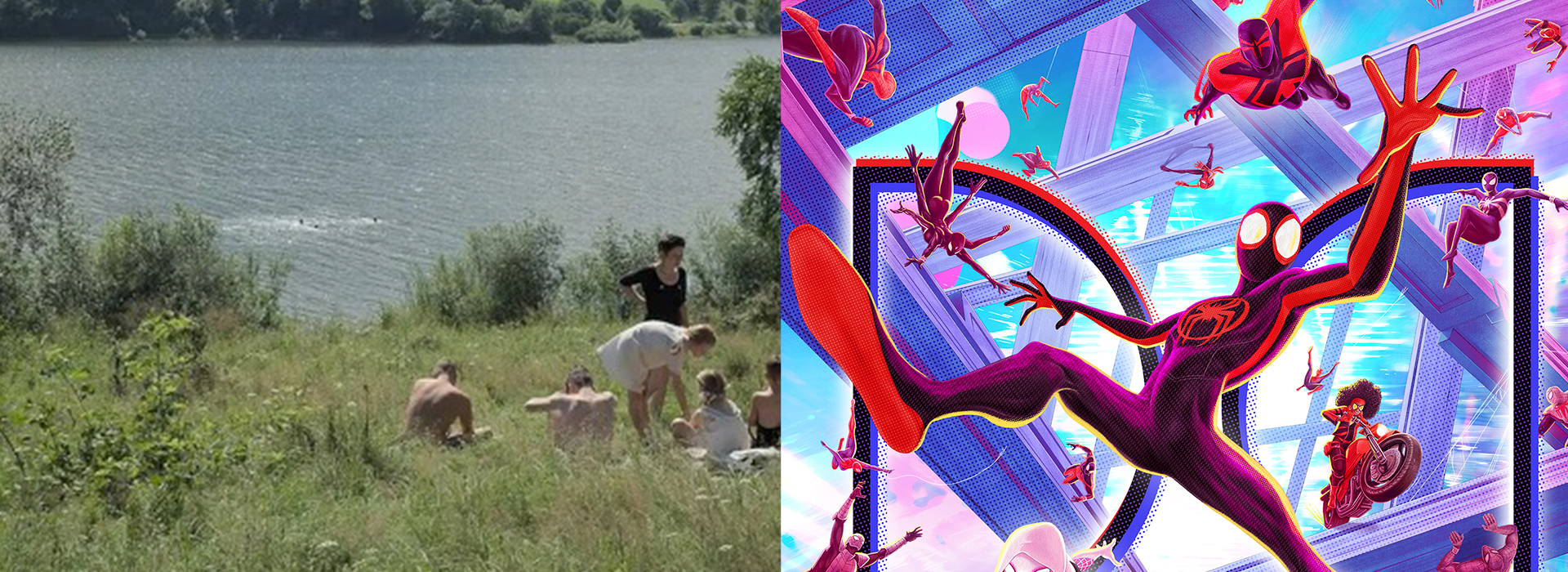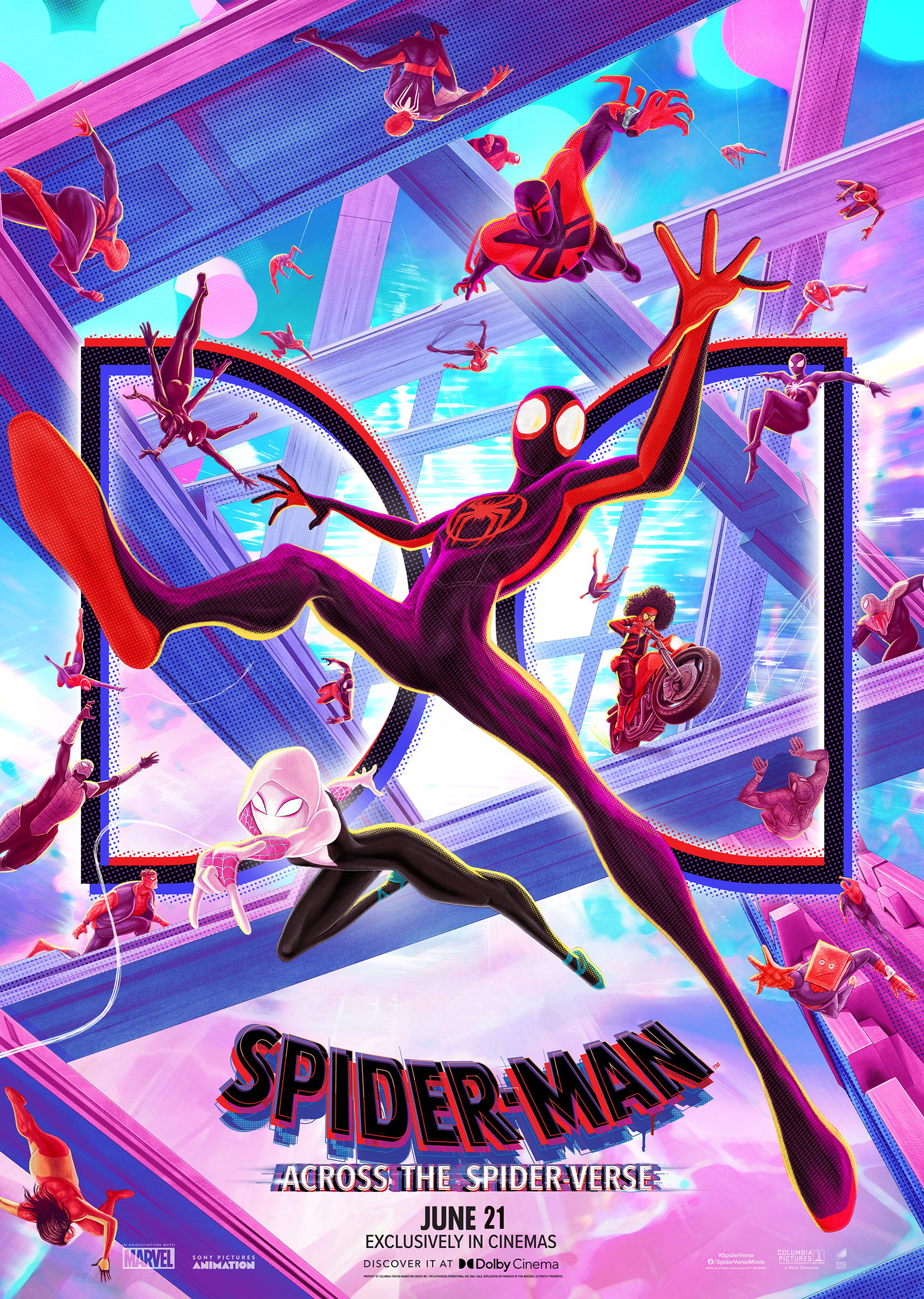
Starting in July, film critic Kim Haery will be interpreting two movies for WEVERSE Magazine each month. First up is The Zone of Interest and Spider-Man: Across the Spider-Verse.
Editor’s note: If you’re sensitive to spoiler content, please be advised that the below does contain material related to the story.
I skimmed through the book People who Fast-forward through Movies (映畵を早送りで觀る人たち). The author Toyoshi Inada discusses the growing phenomenon of skipping and fast-forwarding movies and the reasons behind it. It’s somewhat similar to the chicken-and-egg dilemma, but according to Inada, there is an increase in movies and dramas that explain everything through dialogue, so fast-forwarding doesn’t hurt. Inada also claims that today’s audience that fears failure more than any other generation causes a rise in preference for Youtube recaps that ensure entertainment. Failure? I pause for a moment. Failure here probably refers to the experience of being knocked off your feet and left shaken and confused by a movie. These are some of the words I use to describe the most intense of watching a film. At the same time, movies can be a bit unimaginative. But why would one watch a movie, a medium so full of uncertainty, if they don’t want to be surprised, mesmerized, or get lost in the story? Maybe I’m addicted to failure.
Barring a catastrophe like COVID-19, the Cannes Film Festival is held every May and celebrates movies that promise “ecstatic failure.” While there are many international film festivals that have come into their own, Cannes remains the most prestigious annual film festival of the 21st century. It’s the place that makes a skeptic reflect on his prejudgment that “There’s so much to be said about a movie that’s over a hundred years old,” and turn the assurance that movie theaters will soon become a relic of the past into a prophecy against civilization. And there’s always one or two movies from the future that leaves you asking “What did I just see?” A film that left a shocking impact at the Cannes Film Festival this year is the latest work from director Jonathan Glazer (Sexy Beast, Under the Skin), The Zone of Interest.
-
 ©️ Festival de Cannes
©️ Festival de Cannes
The first scene opens without any historical context or the year or era. It only shows a long shot of an affluent white family on a peaceful summer picnic. The father and the boys are the first to leave, followed by the girls, and finally the mother with her infant. The sun sets, the hour between dog and wolf begins, and the family returns to the mansion with a meticulously kept garden and a swimming pool. The next day, the family celebrates the father’s birthday and the mother distributes clothes that have been delivered from somewhere to the servants. It’s a seemingly serene life, but something is out of place. Where is the black smoke rising in the distance coming from? Is that barbed wire stretched over the wall? Above all, what is this creepy rumbling sound – of which the distance is perceivable in the theater only – in the background? Then the audience realizes. The protagonist Rudolf (Christian Friedel) is the Nazi commandant of the Auschwitz concentration camp Rudolf Höss, who ran the camp from 1940 to 1945. The mansion so elaborately tended by Hedwig (Sandra Hüller) is their residence separated by a single wall from the camp. The Höss residence, like in The Empire of Lights painted by René Magritte, is a lone house glowing in complete darkness. And the close by Auschwitz camp is out of their “zone of interest.” (Albeit it may be in their “zone of interests.”) Carts full of clothes and jewelry confiscated from massacred Jews are conveyed to Hedwig across the screen from right to left, and Nazi officers stroll by with hounds that hunt down escaped Jews above the grassland where they’re having family conversations. In The Zone of Interest, the tension reaches its peak when Hedwig learns that Rudolf is to be transferred, and tells him that she’d rather stay with children than leave their paradise adjacent to the camp. Hedwig goes on to say that the mansion is “leaving space (Lebensraum)” the Führer declared. The concept of Lebensraum was adapted by Adolf Hitler in his political manifesto Mein Kampf. It refers to a living space that the German deserves, obtained by driving out “the inferior race.”
The Zone of Interest shocked the audience in Cannes because it extra-linguistically maximizes the expressive possibilities of cinema instead of using traditional storytelling. Jonathan Glazer has no interest in conveying the twists and turns of the Holocaust; he draws a psychological map of a fascist couple through immaculately composed long shots. The film mostly shows the compartments in the perpetrators’ minds and the movements of people, animals, and objects. The couple divides the world according to Germanic fascism and designs the most efficient pipes to “take care of” the remaining inferior race. Upgrading the genocide and crematorium is Rudolf’s pride. From this perspective, The Zone of Interest is a door-locking movie. (Sorry, Suzume!) Hedwig and Rudolf relentlessly close and lock doors at home and at work. Glazer and his cinematographer take things further and shoot the continuous action of the actors shutting multiple doors with motion-controlled cameras installed around the set to make scenes seamless. However, toward the end of the movie, they make a quantum leap in editing. It involves the one “door” the Nazis couldn’t shut down. The door opens at the moment when the gaze of the Nazi officer meets with the gaze of the audience, the humanity of the future. As we watch the movie in the darkness of the theater along with anonymous contemporaries, the eye contact becomes a question that connects us on and off the screen: Aren’t the tragedies currently happening in the world being excluded from our zone of interest?
In his movie, Jonathan Glazer abandons the narrative of causality and stages an inscrutable slice of history. It is Mica Levi’s persuasive scoring that makes the audience wonder if this is closer to a performance than a movie. Before Lanzmann, Alain Resnais interweaved archival footage of the concentration camps during WWII and of the Auschwitz camp in the 50s together in his 1956 film Night and Fog (Nuit et brouillard). While the music in Night and Fog soothes the wounds of the horrific images, the music in The Zone of Interest warns the Nazis, who may yet be defeated, about their carefree routine. Mica Levi’s bizarre scores that are difficult to distinguish between natural sounds and musical sounds are a part of the performance that sing different “lyrics” from the screen.
The Zone of Interest is not the only movie that chose the score as one of its backbones. Among this year’s films of Official Selection in Competition, Club Zero, Anatomy of a Fall, and May December used natural sounds and musical sounds in an extremely expressive way. Todd Haynes, the director of May December, even said that he “built a movie based on the score.” At last year’s Cannes Film Festival, Apichatpong Weerasethakul asked the question “Is sound an element of cinematography?” through his movie Memoria, and directors were racing to come up with their own response first. Naturally, a theater is needed to convey the delicately edited music and sound as intended by the director. In short, The Zone of Interest makes theater indispensable for three reasons: cleverly composed long shots that require a big screen, a communal experience, and carefully placed sound.
In a world where we all have personal devices that allow us to watch movies at double speed and not feel guilty about pushing the “exit” button midway through, the “magic of real spaces” is the word on the lips of theater operator companies; it means exploring and promoting the dimensions that the theater space can add to the movie experience. For example, forced immersion has become a scarce resource that theaters offer in an era of attention deficit. Yet, a recent trend in theaters is the multiverse narrative, which paradoxically seems to be a cinematic representation of ADHD, starting with Spider-man: Into the Spiderverse (“New Universe”), followed by the successful Spider-man: No Way Home (2021) that brought together Tobey Maguire, Andrew Garfield, and Tom Holland, and Doctor Strange in the Multiverse of Madness (2022) that used the multiverse as a mainstay. Meanwhile, the multiverse family drama Everything Everywhere All at Once, which caused a tremendous commotion at Sundance Film Festival in 2022, maintained its momentum for almost a year before winning the Academy Award for Best Picture in March 2023.
From Marvel Studios’ perspective, the multiverse seems to be a good choice to carry the cumulative load of a comic-style narrative that ramifies narratives sideways and parallels. But can the structure of the multiverse, as a sub-genre, really support multiple films with diverse stories? Wasn’t the popularity of Spider-man: No Way Home due to the thrill of seeing three Spider-Men in the same frame, rather than the appeal of the multiverse itself? Similarly, the Marvel Cinematic Universe’s promise of including more multiverse action in the movie Ant-Man and the Wasp: Quantumania, which opened Phase 5, summoning a myriad of versions of the villain Kang from the TV series Loki, didn’t attract much attention.
While Marvel struggled, Sony’s second installment of its trilogy – or rather, part one of it – Spider-Man: Across the Spider-Verse turned the theory that animation is the best form for multiverse narratives into a conviction. The story of Miles Morales and Gwen Stacy’s coming-of-age tale is hardly new. It’s also similar to that of the DC superhero movie The Flash, which was released around the same time. The real strength of Spider-Man: Across the Spider-Verse is that it borrows not only its multiverse narrative but also its style and aesthetic from the comics, the cradle of superhero cinema. In the movie, the character design corresponds to the world he or she belongs and each numbered universe has its own unique art style. Gwen’s New York is a painterly landscape of pastel blues and pinks that fluidly reflects Spider-Woman’s emotions and gender identity, while Miles’ New York is a world of hip-hop and graffiti. Hobie’s Big Apple looks like an 80s London punk scene magazine tear-out, and he carries out his missions as if he is performing like a rockstar thrusting out his instrument. Miguel O’Hara’s Earth, the head of an organization that protects the great principles of the multiverse, is portrayed in the style of a cyberpunk graphic novel, with precise mechanics. The Vulture, from a Renaissance-style universe, is drawn with lines scratched with a feather pen on parchment. Animation is a great vessel for the multiverse because it allows for much more flexibility in the tone of the screen and the choreography of the action compared to live-action.
Spider-Man: Across the Spider-Verse, which offers an experience that feels like viewing a pop art exhibition on a huge screen for two hours and twenty minutes, makes Marvel’s CGI-heavy live-action films look relatively shoddy. The movie takes a page from Everything Everywhere All at Once and advances the multiverse plot as a metaphor for life instead of using it as a plot device. For example, the strangest scene in the movie is where Gwen unmasks herself and reveals her true identity. The father who believed Spider-Woman to be an evil murderer doesn’t lower his gun even after seeing his daughter’s face. Why? For the young LGBTQ+ audience in the U.S., this scene reminds them of their parents who showed enmity toward them after they came out of the closet despite the love they had for them. Desperate, Gwen leaves her father and turns to the Spider-Man community. It is a coming-out in a superhero movie following the step of Magneto and Professor Xavier’s meeting with Iceman’s parents in X2: X-Men United. Miles is an honor student, but as a black father and a Puerto Rican mother, his parents worry about whether the world will accept him or not. His mother’s advice, “Never listen to anyone, anywhere, who tells you, ‘You don’t belong here,’” is echoed by Miles when others cast doubts on him.
Spider-Man: Across the Spider-Verse is also a love letter to the world of comics from which it originated. The villain Spot, shaped like a simple drop of ink on a blank page, creates wormholes to travel through the multiverse, just as the comics open up to infinity from the moment a dot is placed on a paper. The character of Miguel O’Hara, who ensures that the various Spider-Men writing their own narratives in countless universes stay within the bounds of canon, is reminiscent of the editors at Marvel Comics headquarters. The battle between free will versus the universal principles of the existence of comics and the multiverse will be resolved in the final installment, Spider-Man: Beyond the Spider-Verse, scheduled to be released in 2024, although the title itself seems like a bit of a spoiler.
7. 2023
Unauthorized reproduction and distribution prohibited.
